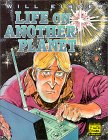

| Life on Another Planet. By Will Eisner. New York: DC Comics, 2000. 128p. (The Will Eisner Library). $12.95. ISBN 1-56389-677-X. |

|
GENRES: AUDIENCE: NOTE: This book was previously published under the title "Signal from Space" and has copyright dates spanning 1978-1995. SYNOPSIS: Cobbs's death prompts the Soviets to send another agent to find out what Cobbs had discovered. Meanwhile, the CIA contacts Dr. Bludd, an astrophysicist, and make him Cobbs's replacement to find out what's going on. By poring over Cobbs's papers and tapes, Bludd learns about the signal from space. He confronts Argano and Malley, who shamefacedly admit their guilt, but before Bludd can do anything, his secretary shows up. She's Nadia, the new Soviet spy. She and her cohorts makes off with Argano, Malley, and all the papers and tapes and leave Bludd unconscious in the lab, which they set afire. But Bludd manages to crawl out of the building and spends several months recuperating. Meanwhile, the news of the signal has made it into the general public. Marco, a drunken bum, hears a broadcast about the signal and has a spiritual experience: he will start a new life on the new planet. He immediately captivates Cora, a waitress, and starts his "Star People" movement with her and a handful of bums. They set up on a street corner, looking for new recruits. From the gutters we move to the offices of Multinational, a corporation that "is a government in itself... we are above the politics of any one country!" They want to "push the USSR and the U.S. into a space race" in order to profit from the expanded space programs in both countries. Macready, one of Multinational's board members, has a chance encounter with Cora (he allows her to get into his limo when she's threatened with arrest) and decides to start funneling millions of dollars to the Star People. (His motives for expanding the group are to create a host of "eager... er, voyagers" to ride a dangerous deep space probe ship.) In a biological laboratory, Dr. Crowben reveals to his colleagues Dr. Hoad and Dr. Jones that he's dying. To give Dr. Crowben's death a purpose, the three decide to use his cells to create a human-plant being that could survive on the new planet. For funds, they tap the coffers of the Star People. Grebe, the Multinational plant in the Star People, tells his superiors about the experiment, and the scientists are given a lab to work in. Bludd, fully recovered, is back with the CIA. He's given a job with Multinational in Berlin in order to make contact with Argano and Malley, who are fetched to Berlin by other operatives. The two won't leave Russia because they've been given a "good lab [and] status," but they do tell Bludd about the info they passed to the Soviets. They also reveal that the Soviets will be using neutrinos to signal the planet in response to its original signal. Bludd decides he must go into Russia to get a peek at the Russians' calculations. Leaving Malley behind as a CIA hostage, Argano accompanies Bludd to Moscow. As Bludd photographs the calculations, they're discovered by Nadia, who turns out to be Argano's lover. Rather than let her reveal their presence to the KGB, Argano strangles her to the point of unconsciousness and urges Bludd to get away. However, Bludd's contact in a border town turns up dead, and he has to rush to the American Embassy. Back in the States, Bludd meets with Macready and sits in on a meeting of the Tripartite Commission, which is discussing the general world response to the space signal. Drs. Hoad and Jones report on their successful creation of the new lifeform. Just as Bludd begins to explain what he knows, they learn about Sidiami, a small impoverished African state that has seceded from Earth and declared itself a colony of the new planet (in order to escape the debts it owes). They Commission decides to build their launch pad in that rogue state, as they know they will never be able to get the backing of the U.S. government. Bludd is disturbed by what he's hearing; he feels that the Commission is making decisions "that will nfluence the future of life on Earth with no concern for the consequences!" He storms out of the meeting and marches straight to the President. But while the President is on Bludd's side, his Action Memo is inadvertently delegated to a man who is easily swayed by the persuasive words of Multinational's pet senator, and the "stop" order is delayed. This synopsis is getting awfully long, and I'm only halfway through the book. The second half is full of action as the various participants in this great game (several other sets as well as the ones mentioned above) try to get what they want, with motives as simple as greed and revenge and as complex as love. Some of the "good guys" turn bad, while some of the "bad guys" end up on the side of the angels. The book contains a lengthy introduction by the science-fiction author James Morrow, who expresses his admiration for Eisner's handling of a situation that seemed to defy fictionalization: the effect on humans when they finally received a signal from space. EVALUATION: On the minus side, the science and depiction of scientists is dubious at best. (Even Morrow admits that "the 'science'... is indeed rather rubbery.") In this story, Eisner appears not to have known the first thing about the science or math behind science fiction; and while the main goal of the story is not hard science so much as social science, Eisner's neglect of the hard science aspect distracted me from the social points he was trying to make, because I kept thinking, "How stupid!" For one thing, the number sequence that's beamed to Earth is referred to by the scientists as numbers that "can be divided by one... or by themselves"--in other words, prime numbers, yet this extremely basic phrase is not mentioned. Similarly, when the two scientists ask Bludd if he's heard of neutrinos, it's akin to someone asking me if I know what nouns are. (Like, duh!) While I can suspend disbelief to accept the creation of a human-plant lifeform, I refuse to believe that the scientists have gleaned enough data from their very sketchy information about the "planet Barnard" to automatically assume that their lifeform is the only kind of life that can thrive there. Another error, one around which the story hinges, concerns light-years. Eisner made the common but annoying mistake of treating light-years as units of time rather than distance, so that the characters are constantly referring to the ten-light-year journey to "planet Barnard" as being a ten-year one. There are other such errors in the book. (BTW, the proper name for the star is "Barnard's star," and it's about 5.9 light-years away, not 10. Any planet it might have [and it possibly has one] would either be named after [or by] the discoverer, given a boring catalogue name like "Barnard 1," or assigned a name based on whatever the astronomical naming criteria are for extrasolar planets. It's highly unlikely to be called "planet Barnard" or just "Barnard." Check out the Gazetteer of Planetary Nomenclature for more info. God, I love the Internet!) The point is made in Morrow's essay that the real focus of the book is on the human reaction to the signal. This is certainly true, and to some extent Eisner succeeded in depicting and satirizing this reaction. I do believe that at least one, and likely several, religious cults would immediately spring up when the news is released. The behind-the-scenes maneuvering at all levels is also believable, though I think the US government would be far more eager to explore the signal than Multinational thought they would be. The secession of Sidiami is bizarre, though one must recall that Idi Amin (on whom the Sidiami dictator was obviously based) was not a rational person and could conceivably have done something that weird. The plant-based lifeform thread, probably the most sci-fi element in the story, was not at all plausible; a first probe sent to "planet Barnard" would have nothing but instrumentation aboard it, and certainly not some kind of colonist. The spy stuff between the US and the USSR is plausible, but somewhat overemphasized in this book. Many of the characters are reasonably well rounded, though some come off as mere stereotypes, and a lot are killed before we get to know them. As I mentioned above, I thought Bludd was very well drawn. Another good character was Dr. Hoad, whose single-minded pursuit of science leads him to a tragic event. (Except for Hoad, though, none of the scientists seemed like scientists--they were more like lab assistants out of their depth.) The various Mafia types that float around have unexpected depths, though maybe they shouldn't be considered so unexpected, given Eisner's previous works. A minor problem lies in the lettering, which is riddled with typos. For example, Barnard's Star is referred to variously as "Bernard's Star," "the star Barnard," and "the star Bernard," and the list of prime numbers neglects 2 and prints "33" instead of "23." I love Eisner's work dearly, which made criticizing this ambitious book unpleasant. But it's a surprisingly sloppy work that could have been much better, story-wise. Within its constraints it's well plotted and taut and, of course, wonderfully illustrated. Because it's one of his few works of SF, it belongs in a library of Eisner or SF graphic novels. However, it is not a first choice for newcomers to the Master's work. Really, he's much better at character studies, Jewish stuff, crime stories, and urban fantasy. |
Return to Rational Magic Home
